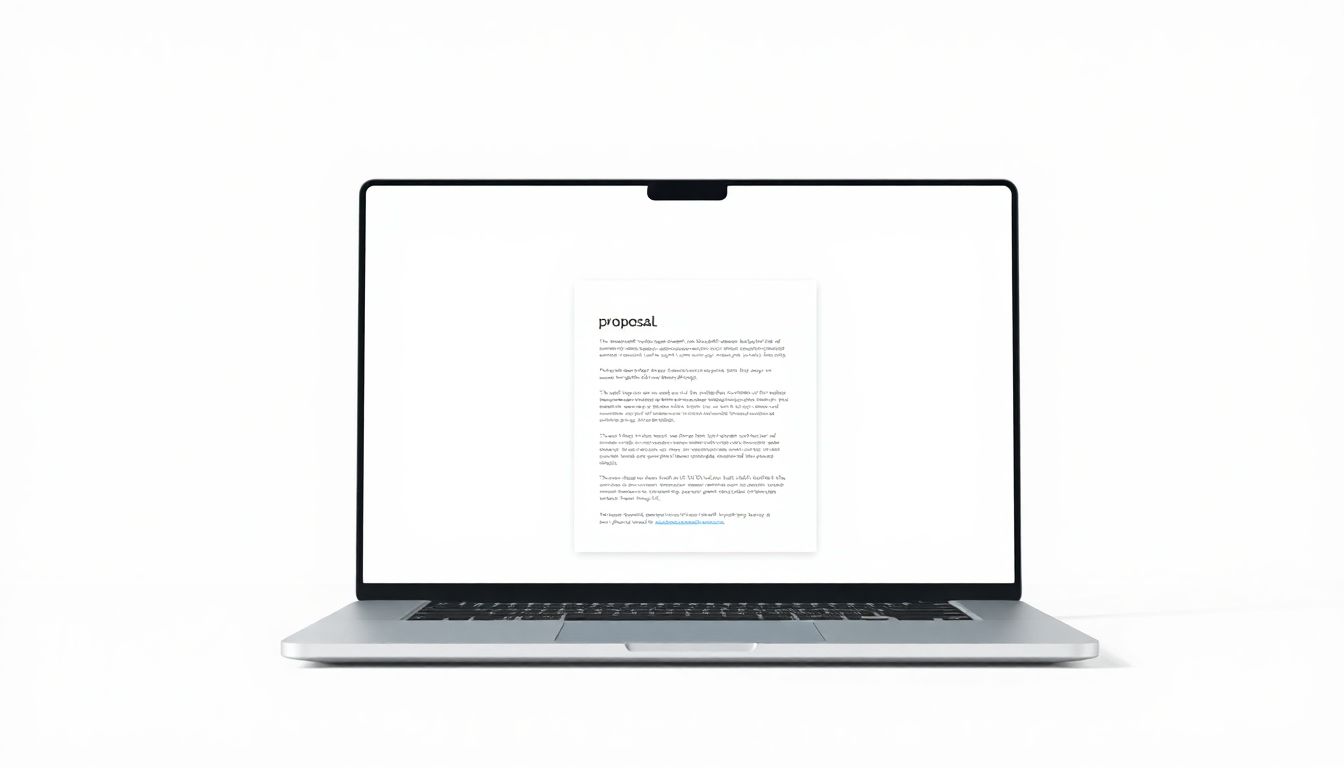Looking for a way to streamline your proposal process? I get it—writing proposals can be time-consuming and might leave you wishing for a magic wand. Luckily, AI proposal automation tools promise to make the whole thing faster and less stressful, but with so many options out there, choosing the right one can feel overwhelming.
Stick with me, and you’ll learn how to find the best AI proposal tools for 2025, what features truly matter, and how to pick the perfect fit for your business. By the end, you’ll have a clear idea of how to use these tools to save time and land more wins—without losing your mind.
Let’s get started and discover how the right AI proposal automation tools can become your new best friends in business!
Key Takeaways
Key Takeaways
- Choose AI proposal tools that save time, improve accuracy, and connect easily with your existing systems. Look for features like automation, personalization, and smart insights. Read reviews to find proven benefits such as faster proposals and higher win rates. Focus on tools that fit your business size and needs, especially those with good collaboration options and user-friendly interfaces. Testing demos and checking pricing helps in selecting the right fit without overspending.
- Key features to prioritize include automation of repetitive tasks, content personalization, integration with CRMs, and tracking analytics. The right tool should be easy to use and support team teamwork. Platforms like SellAItool offer secure, efficient environments, making proposal creation quicker and more effective for your goals.
- Popular AI proposal tools in 2025 include ChatGPT for content ideas, Proposify for custom templates, and Qwilr for visual proposals. Marketplace options like SellAItool help discover top-rated tools and AI resources, ensuring you find solutions suited for your specific needs and budget.
- Select a tool based on your business size, industry, and goals. Smaller teams might prefer simple platforms like Proposify, while larger companies benefit from more advanced options with integrations and analytics. Check if templates focus on your industry, support team collaboration, and fit within your budget. Demo multiple options to find the most convenient and useful choice.
- Choose proposal automation software by matching features to your needs, prioritizing ease of use, ongoing support, and future growth. Request demos, read user reviews, and consider scalable plans. Ensure the platform can adapt with new features so it remains useful over time and doesn’t hinder your workflow.
- To use AI proposal tools effectively, build templates and collections of content, feed the AI with your best proposals, and automate data inputs. Monitor analytics to see what works, involve your team early on, and review AI-generated drafts for a human touch. Staying updated with new features will help you keep your process efficient and competitive.

1. How to Find the Best AI Proposal Automation Tools in 2025
Finding the top AI proposal automation tools in 2025 starts with understanding what really matters. Look for platforms that save you time, boost accuracy, and integrate easily with your existing workflow. Start by checking recent market growth — the AI proposal automation market was worth around $1.2 billion in 2024 and is expected to hit $7.5 billion by 2033, showing rapid expansion and innovation source.
Next, identify tools that automate key tasks like data gathering, content generation, and proposal formatting—these features can cut proposal creation time by up to 5x. Don’t forget to read reviews and case studies to see how businesses like yours are benefiting. For example, companies report faster turnaround times and increased win rates after implementing AI-driven proposals source.
Finally, evaluate if the tool offers smart features like AI-powered insights, customizable templates, and easy collaboration options. Tools such as SellAItool provide a streamlined environment for buying, selling, and managing AI proposal solutions, ensuring you’re investing in tools ready for the future.
2. Key Features of AI Proposal Automation Software
The most valuable AI proposal tools pack a punch with features that make your life easier. Look for automation of repetitive tasks like data extraction, which frees you up for more strategic work. Personalization comes from AI-generated content tailored to your prospect’s needs, increasing your chances of winning the deal.
Another must-have is integration capability—your proposal software should seamlessly connect with CRM, marketing, and document management systems. Many top contenders also offer analytics dashboards so you can track proposal success rates and refine your approach over time.
Ease of use matters too—look for intuitive interfaces and support for team collaboration, especially if multiple people are involved in crafting proposals. For example, platforms like SellAItool focus on security, verified data, and an easy onboarding process, making sure you’re not just buying flashy features, but real value.
3. Top AI Proposal Tools in 2025 and What They Offer
By 2025, the AI proposal landscape has grown significantly, with several tools standing out for their specific strengths. For example, ChatGPT is widely used for automating research and drafting content thanks to its advanced language understanding, achieving 1 million users in just five days back in 2022 source.
Other notable tools include Proposify—which offers customizable templates and e-signature integration—and Qwilr, known for their visually appealing proposals powered by AI insights.
For those aiming to buy or sell AI-driven proposal assets, SellAItool provides a secure marketplace to discover top tools and AI websites with verified performance, making it easier to find the perfect fit for your business needs.

4. Which AI Proposal Tool Fits Your Business Needs
Choosing the right AI proposal tool isn’t a one-size-fits-all deal—your business’s size, industry, and goals matter.
Start by asking yourself whether you need a simple content generator or a full-fledged proposal management system.
If you’re a small team looking for basic automation, tools like Proposify might suffice with their easy-to-use templates and e-signature features.
For larger organizations needing deep integrations with CRMs and analytics, platforms like Allego or Qwilr can handle complexity better.
Look into whether the tool offers industry-specific templates; some solutions tailor content for sectors like tech, healthcare, or finance, saving you from building everything from scratch.
If collaboration is key, ensure the platform supports multiple users editing proposals simultaneously and offers commenting features.
Finally, consider your budget and how much training your team will need—some tools are simpler to pick up, while others require onboarding sessions.
Demo several options, ask for trial periods, and see which platform aligns best with your workflow, so you don’t buy a solution that becomes an obstacle, not a helper.
5. How to Choose the Right AI Proposal Automation Software
Picking the right proposal software is about matching features to your needs while not breaking the bank.
First, list what’s absolutely necessary: Do you need customization, analytics, collaboration, or integrations?
Next, check if the vendor offers good support, onboarding help, and regular updates—nothing worse than facing a tool that gets outdated or is hard to use.
Always ask for a demo and test the platform with a sample proposal to see how intuitive it feels and whether it actually speeds up your process.
Read real user reviews to understand common pain points or helpful features others have discovered.
Keep an eye on pricing plans—some platforms offer tiered options that scale with your business, so start small and grow into more features.
Finally, verify if the software can adapt to future needs, like adding new templates or AI features, so you’re not stuck with a tool that will soon be obsolete.
In the end, the goal is to find a platform that simplifies your proposal work without adding complexity or extra costs.
6. Tips to Use AI Proposal Tools Effectively in 2025
Getting the most out of your AI proposal tool takes a bit of strategy—here are some practical tips.
Start by creating a library of reusable content and templates so you don’t reinvent the wheel each time.
Train the AI by feeding it your best-performing proposals; the smarter it gets, the better your drafts will be.
Set up workflows that automatically pull data from your CRM or project management systems to keep proposals fresh and accurate.
Use analytics dashboards to track which proposals win more often and adapt your approach accordingly.
Involve your team early—collaborate in real-time, get feedback, and make revisions faster.
Don’t forget to review AI-generated content to add a human touch, making proposals more engaging and less robotic.
Finally, stay updated on new features and AI advancements—what’s cutting-edge today might be standard tomorrow, saving you from falling behind.
FAQs
Focus on features like customizable templates, integration capabilities, collaboration options, and AI-driven insights to ensure the tool fits your business needs and streamlines proposal creation effectively.
Compare key features, consider your team’s workflows, evaluate ease of use, and check for integrations with existing tools to find a solution that aligns with your business goals and processes.
These tools save time, reduce errors, improve consistency, and help craft compelling proposals faster, increasing your chances of winning more business opportunities.
Regularly train your team on new features, customize templates to fit your branding, and utilize AI suggestions to enhance proposal quality and speed up the process.